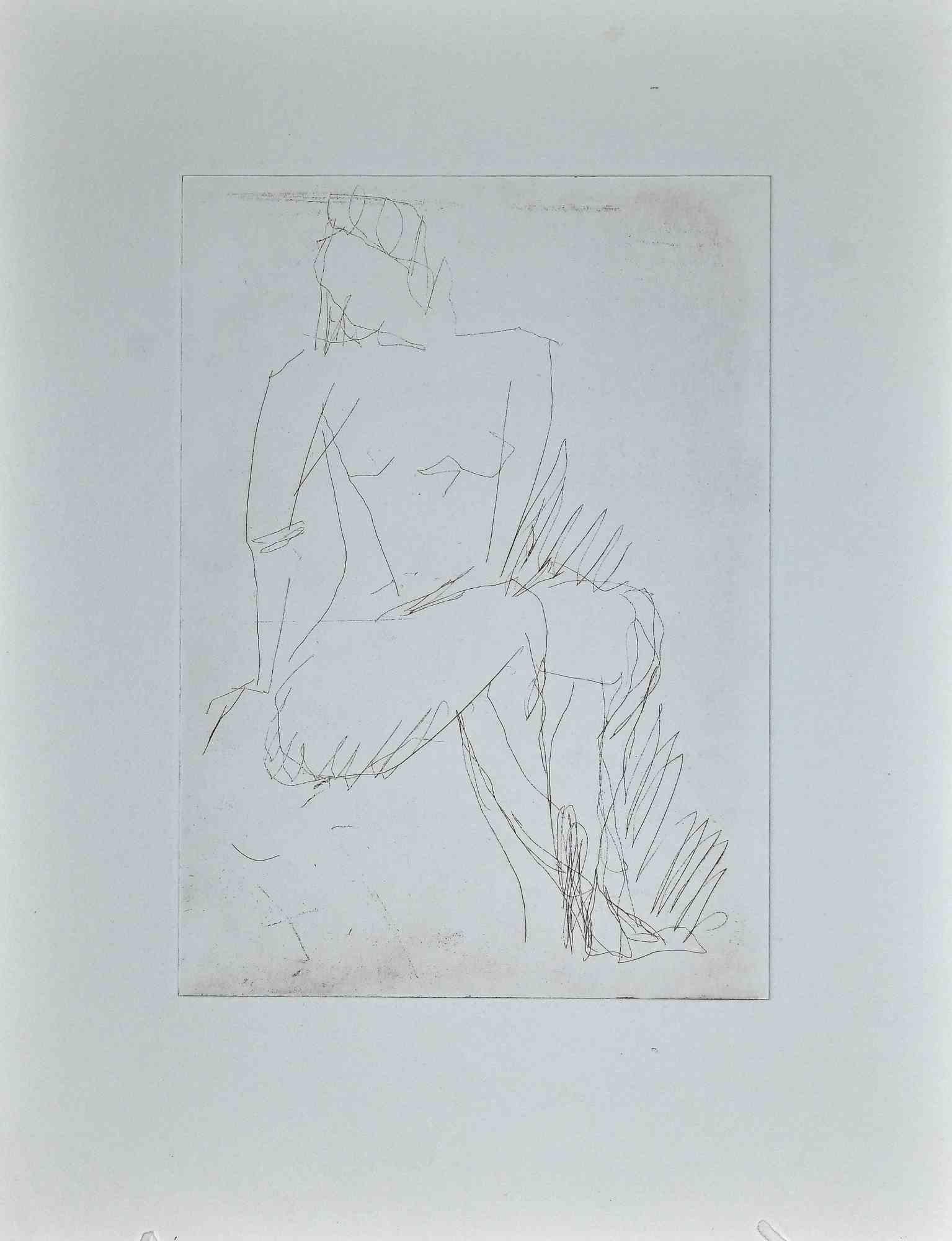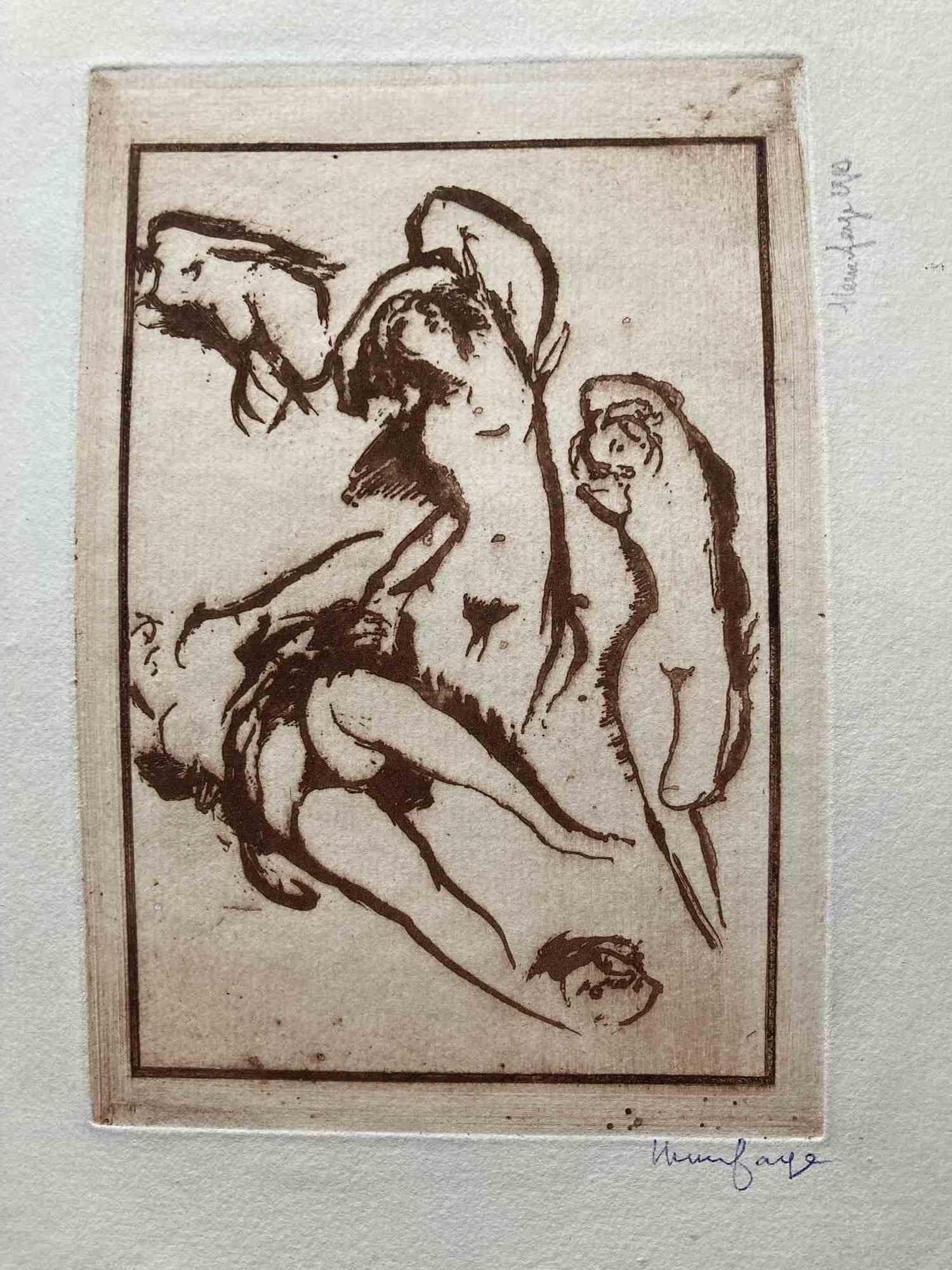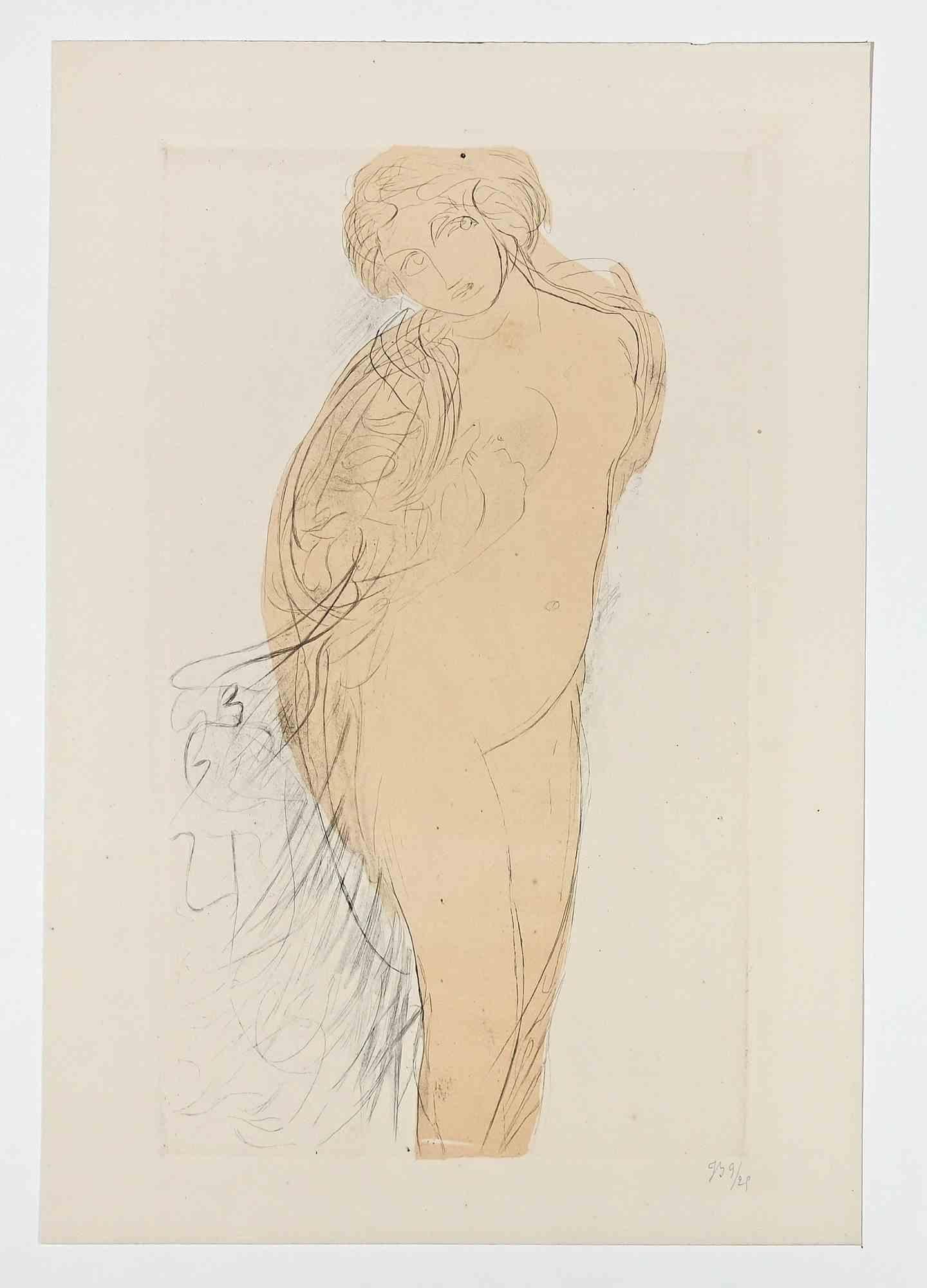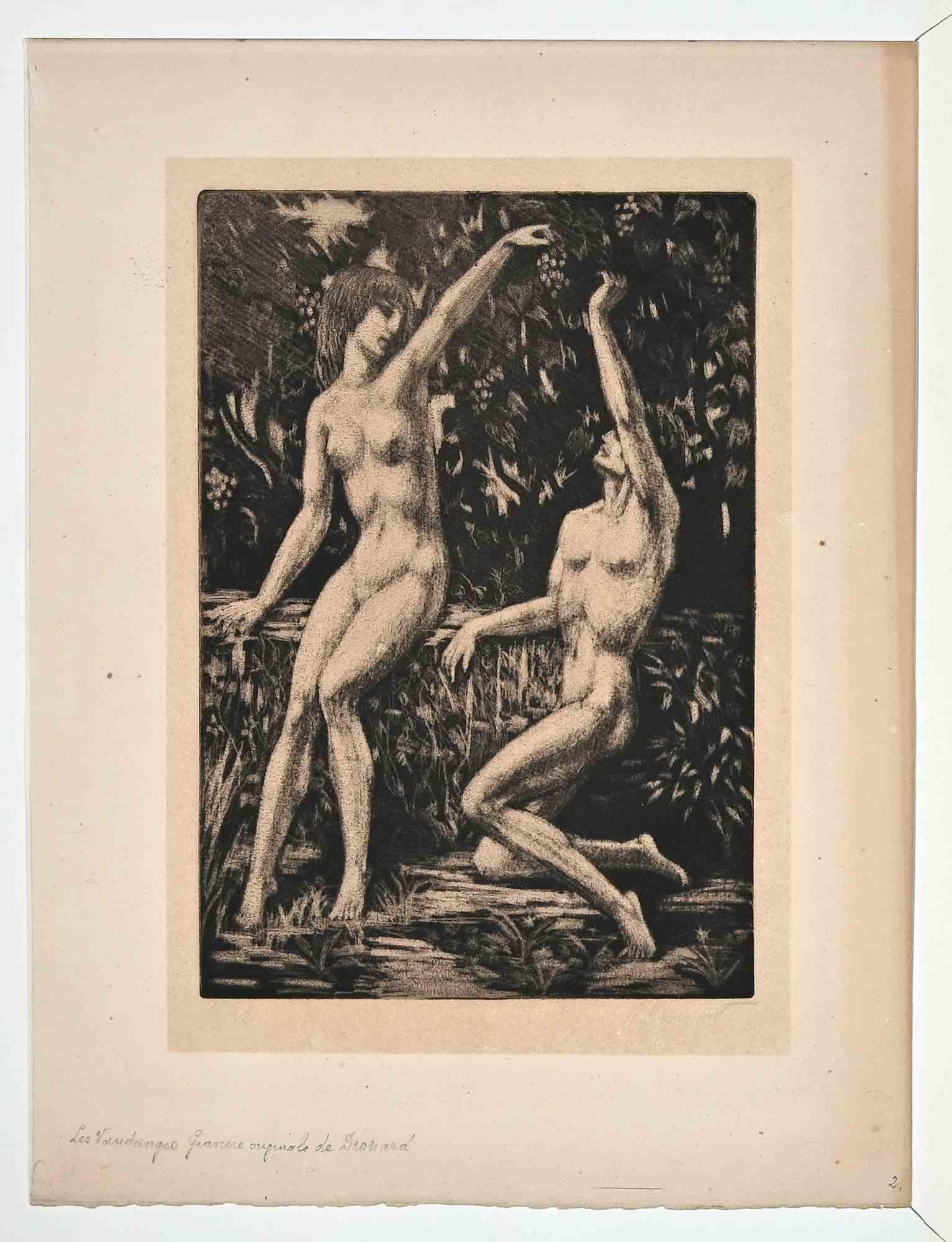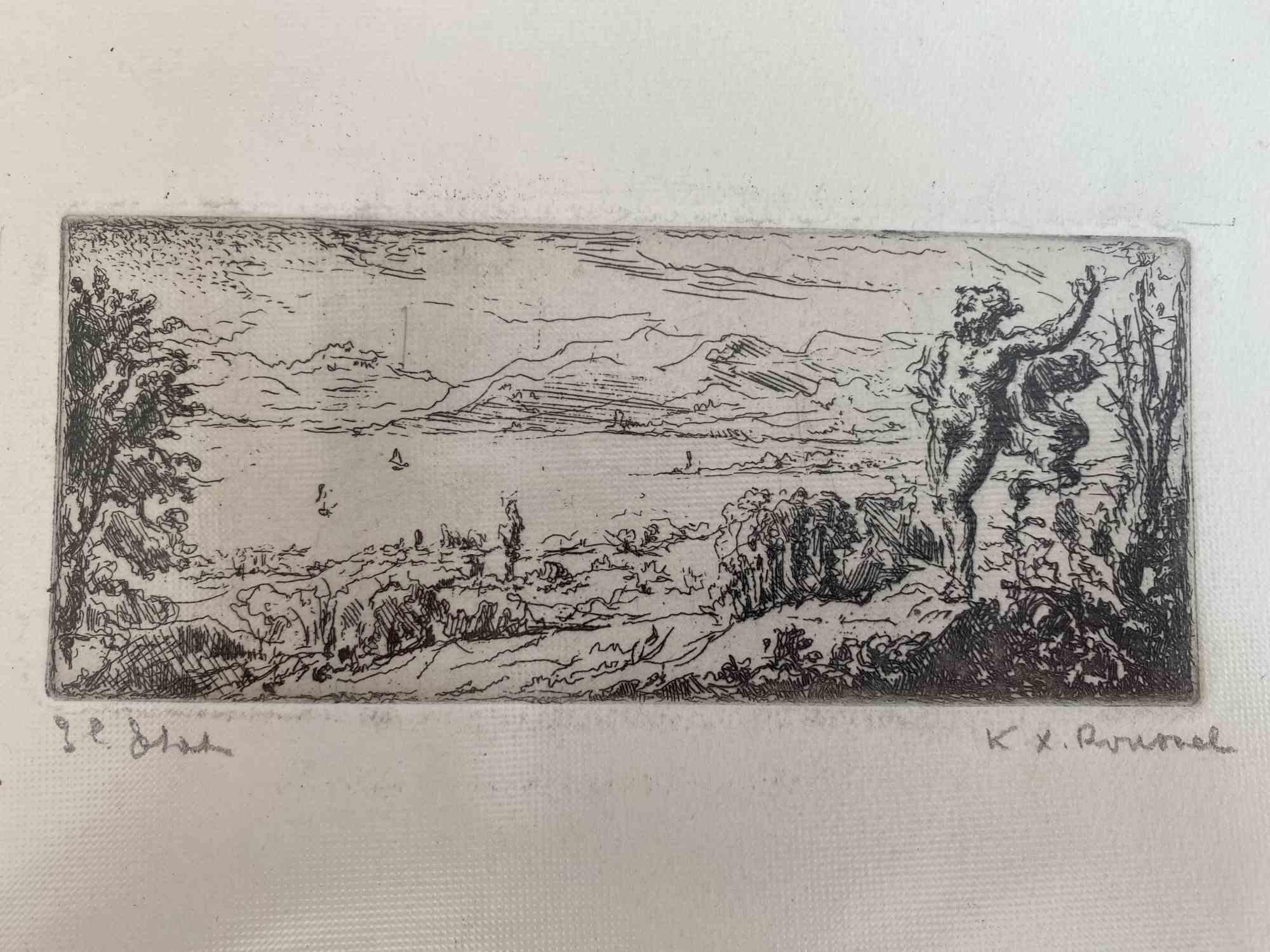Leonor FiniLeonor Fini - Untitled - Original Handsigned EtchingCirca 1982
Circa 1982
About the Item
- Creator:Leonor Fini (1908 - 1996, French)
- Creation Year:Circa 1982
- Dimensions:Height: 27.17 in (69 cm)Width: 20.56 in (52.2 cm)Depth: 0.04 in (1 mm)
- Medium:
- Movement & Style:
- Period:
- Condition:
- Gallery Location:Collonge Bellerive, Geneve, CH
- Reference Number:1stDibs: LU16127067322
Leonor Fini
Leonor Fini was the life of the party during the French Surrealist movement. A socialite with connections to some of the movement's biggest names, Fini was also an astoundingly gifted artist in her own right. In fact, many consider her to be the most fiercely independent female artist of the 20th century. A theatrical personality, Fini created prints, paintings and drawings that are widely revered for their sensuous qualities and raw energy.
Fini's life started off in a dramatic fashion, which was perhaps a portent of things to come. She was born in Buenos Aires, Argentina in 1907, but her parents separated soon after and her mother took her away to Trieste, Italy. Due to her father's attempts to kidnap her, Fini was often dressed as a boy throughout her childhood.
Fini was surrounded by artistic women in Trieste, and she naturally developed a love for art as well. By the time she was 17, she had become familiar with Renaissance art and Mannerist painting and was exhibiting her own portraits. In 1931, at just 24 years of age, Fini moved to Paris and became acquainted with influential artists Giorgio de Chirico and Carlos Carrà. She also met and started a romantic relationship with Surrealist pioneer Max Ernst, who introduced her to others in the movement.
Though she had no formal art education, Fini proved herself to be both technically masterful and creatively exceptional. Her work and her flamboyant personality attracted the attention of many of the 20th century's most celebrated artists and thinkers, including Salvador Dalí, Jean Cocteau, Albert Camus and Jean Genet, just to name a very few. She exhibited her work in many Parisian art galleries, including the gallery of Christian Dior before the fashion icon became a designer.
In the 1950s, Fini continued painting while immersing herself in other artistic and dramatic endeavors, including theater costume and mask design. She also designed posters for the Paris Opera and wardrobes for movies.
Fini continued living and painting in Paris for the rest of her life. She died in 1996.
On 1stDibs, find original Leonor Fini prints, paintings and drawings.
- ShippingRetrieving quote...Ships From: Collonge Bellerive, Geneve, Switzerland
- Return PolicyA return for this item may be initiated within 7 days of delivery.
- Ossip Zadkine - Ultimate Step - Original EtchingBy Ossip ZadkineLocated in Collonge Bellerive, Geneve, CHEtching monogrammed in the plate. Illustration for a Robert Ganzo's poem "Lespugue" Editions Marcel Sautier, Paris, 1966. Conditions: Good Conditions Dimensions: 25,5 x 16,5 cm. Vellum paper Référence Czwiklitzer n°55. 1890 Zadkine was born on the 14th of July in Vitebsk, a city in Belarussia, on the Dvina. His father Ephime teaches classical languages at the local seminar. His mother Sophie Lester descended from Scots, who emigrated at the time of Peter the Great. 1905 His parents send him to Sunderland, in the North of England, where his mother’s family lives. He studies English and attends modelling courses at the local Art School. 1905-1909 He travels to London without his parents permission where he attends courses at the Regent Street Polytechnicum. In order to earn his living, he plans to work with a stonecutter. He visits the British Museum and studies classical sculpture there. Returns to Smolensk where he produces his first sculpture. Goes back to London. 1909-1910 Zadkine settles in Paris and studies in the ecole Nationale des Beaux-Arts. Finds a workshop in a building called La Ruche, in the XVe arrondissement. 1911 Zadkine presents statues and drawings at the annual Salon d’Automne and at the Salon des Indépendants. It is the ‘cubists’ who draw his attention in Paris. Is essentially close to Russian students who get together in a cafe of the ‘Quartier Latin’. Has himself called Joe Zadkine until 1914. 1912-1913 Finds a room in the neighbourhood of Montparnasse, in the rue de Vaugirard. Studies Roman sculpture. Zadkine is immortalized by his neighbour, photographer Marc Vaux, in his new workshop. Meets Brancusi, Guillaume Apollinaire, Jacques Lipchitz, Pablo Picasso, Antoine Bourdelle, Leopold Survage and Robert Delaunay. Henri Matisse visits Zadkine’s workshop. 1914-1915 Exhibition at the Freie Sezession in Berlin, at De Onafhankelijken in Amsterdam (Holland) and at the Allied Artists Association in London. Thanks to collector Paul Rodocanachi, he can settle in a workshop in the rue Rousselet. Becomes friends with Modigliani. 1916-1917 Works as a stretcher-bearer on the front. Produces drawings and watercolours dealing with war. Zadkine is discharged in 1917. He says he is ‘bodily and spiritually’ ruined by the war. After his stay in the Epernay hospital he recovers in Bruniquel, in the southwest of France. 1918-1919 Makes a series of 20 war etchings...Category
1960s Modern Figurative Prints
MaterialsEtching
- André Derain - Ovid's Heroides - Original EtchingBy André DerainLocated in Collonge Bellerive, Geneve, CHAndré Derain - Ovid's Heroides Original Etching Edition of 134 Dimensions: 32 x 25 cm Ovide [Marcel Prevost], Héroïdes, Paris, Société des Cent-une, 1938...Category
1930s Modern Nude Prints
MaterialsEtching
- André Derain - Ovid's Heroides - Original EtchingBy André DerainLocated in Collonge Bellerive, Geneve, CHAndré Derain - Ovid's Heroides Original Etching Edition of 134 Dimensions: 32 x 25 cm Ovide [Marcel Prevost], Héroïdes, Paris, Société des Cent-une, 1938 Andre Derain was born in 1...Category
1930s Modern Nude Prints
MaterialsEtching
- André Derain - Ovid's Heroides - Original EtchingBy André DerainLocated in Collonge Bellerive, Geneve, CHAndré Derain - Ovid's Heroides Original Etching Edition of 134 Dimensions: 32 x 25 cm Ovide [Marcel Prevost], Héroïdes, Paris, Société des Cent-une, 1938 Andre Derain was born in 1...Category
1930s Modern Nude Prints
MaterialsEtching
- André Derain - Ovid's Heroides - Original EtchingBy André DerainLocated in Collonge Bellerive, Geneve, CHAndré Derain - Ovid's Heroides Original Etching Edition of 134 Dimensions: 32 x 25 cm Ovide [Marcel Prevost], Héroïdes, Paris, Société des Cent-une, 1938 Andre Derain was born in 1880 in Chatou, an artist colony outside Paris. In 1898, he enrolled in the Academie Carriere in Paris where he met Matisse. He attended art school and in 1900, set up a studio with Maurice deVlaminck. After his military service from 1900-1904, Derain exhibited his work at the Salon des Independants and then at the Salon d'Automne with Matisse, Vlaminck and others, thus creating the movement of Fauvism.He worked with Henri Matisse in 1905 at Collioure, and participated in the 1905 Salon d’Automne with Matisse, Vlaminck, and Braque, the exhibition in which this group was labeled as Fauves, or Wild Beasts. Along with Vlaminck, Derain was one of the first artists to collect the tribal art of Africa which was influential to many of the artists of the early 20th century. In 1906, Derain met Picasso and his dealer, who purchased Derain's entire studio, creating newfound financial success. During this time, he was hired for the illustrations for works by Guillaume Apollinaire and Andre Breton. After World War I, his friend's Cubism movement affected his art, along with influence from Classicism and African Art. Derain stayed in Paris during most of the Occupation, where he was esteemed by the Nazis because of his artistic integrity. Hitler's Foreign Minister commissioned him to paint a family portrait, but he politely refused. His popularity began to decline after the war because of disagreement over new artistic movements. He later lost most of his eyesight due to illness, which may have been the reason he was hit by a truck in 1954, dying from shock at the age of 74. Derain’s Fauve paintings are typically bright with intense color. Influenced by the work of Cézanne as well as the early Cubist paintings of Picasso and Braque’s, Derain’s style changed and by 1912, the paintings became more traditional and structured. For the remainder of his career, he continued to investigate different compositional methods including the perspective of Cézanne and the pointillism of Seurat. He also designed ballet sets and made a number of sculptures. At the turn of the century, Andre Derain exhibited at the radical Fauve Salon d’Automne (1905) and was one of the founding members of the Fauvist movement together with his life-long friends Matisse and Vlaminck. The works he produced in this period, often under the guidance of Matisse, have been counted among the masterpieces of Fauvism. From around 1918, Derain turned his back on the avant-garde and had begun to explore some of the more traditional genres of Western art, including landscapes. His main source of inspiration once the Fauves group had dispersed was found in the Louvre, where he admired the early Renaissance works in particular. Talking of his frequent visits there, he once said, ‘That seemed to me then, the true, pure absolute painting.’ His work evolved through many styles and, most significantly, turned back to the past, particularly after 1922 when Lenin had publicly pronounced his disdain for abstract art. Derain built up an immense and fascinating collection of paintings, sculpture and objets d’art throughout his life which aided his experimentation and was reflected in his work between 1930 and 1945. During these years, his painting technique displayed the most avenues of invention, using a repertoire of primitivist motifs. His eclectic collection was constantly changing. In 1930 he sold his African collection in exchange for bronzes of antiquity and the Renaissance which indicated a real change of interest in the objects, as did his later pursuit of Greek ceramic painting and his enthusiasm for grand cycles of literary and antique themes...Category
1930s Modern Nude Prints
MaterialsEtching
- André Derain - Ovid's Heroides - Original EtchingBy André DerainLocated in Collonge Bellerive, Geneve, CHAndré Derain - Ovid's Heroides Original Etching Edition of 134 Dimensions: 32 x 25 cm Ovide [Marcel Prevost], Héroïdes, Paris, Société des Cent-une, 1938 Andre Derain was born in 1880 in Chatou, an artist colony outside Paris. In 1898, he enrolled in the Academie Carriere in Paris where he met Matisse. He attended art school and in 1900, set up a studio with Maurice deVlaminck. After his military service from 1900-1904, Derain exhibited his work at the Salon des Independants and then at the Salon d'Automne with Matisse, Vlaminck and others, thus creating the movement of Fauvism.He worked with Henri Matisse in 1905 at Collioure, and participated in the 1905 Salon d’Automne with Matisse, Vlaminck, and Braque, the exhibition in which this group was labeled as Fauves, or Wild Beasts. Along with Vlaminck, Derain was one of the first artists to collect the tribal art of Africa which was influential to many of the artists of the early 20th century. In 1906, Derain met Picasso and his dealer, who purchased Derain's entire studio, creating newfound financial success. During this time, he was hired for the illustrations for works by Guillaume Apollinaire and Andre Breton. After World War I, his friend's Cubism movement affected his art, along with influence from Classicism and African Art. Derain stayed in Paris during most of the Occupation, where he was esteemed by the Nazis because of his artistic integrity. Hitler's Foreign Minister commissioned him to paint a family portrait, but he politely refused. His popularity began to decline after the war because of disagreement over new artistic movements. He later lost most of his eyesight due to illness, which may have been the reason he was hit by a truck in 1954, dying from shock at the age of 74. Derain’s Fauve paintings are typically bright with intense color. Influenced by the work of Cézanne as well as the early Cubist paintings of Picasso and Braque’s, Derain’s style changed and by 1912, the paintings became more traditional and structured. For the remainder of his career, he continued to investigate different compositional methods including the perspective of Cézanne and the pointillism of Seurat. He also designed ballet sets and made a number of sculptures. At the turn of the century, Andre Derain exhibited at the radical Fauve Salon d’Automne (1905) and was one of the founding members of the Fauvist movement together with his life-long friends Matisse and Vlaminck. The works he produced in this period, often under the guidance of Matisse, have been counted among the masterpieces of Fauvism. From around 1918, Derain turned his back on the avant-garde and had begun to explore some of the more traditional genres of Western art, including landscapes. His main source of inspiration once the Fauves group had dispersed was found in the Louvre, where he admired the early Renaissance works in particular. Talking of his frequent visits there, he once said, ‘That seemed to me then, the true, pure absolute painting.’ His work evolved through many styles and, most significantly, turned back to the past, particularly after 1922 when Lenin had publicly pronounced his disdain for abstract art. Derain built up an immense and fascinating collection of paintings, sculpture and objets d’art throughout his life which aided his experimentation and was reflected in his work between 1930 and 1945. During these years, his painting technique displayed the most avenues of invention, using a repertoire of primitivist motifs. His eclectic collection was constantly changing. In 1930 he sold his African collection in exchange for bronzes of antiquity and the Renaissance which indicated a real change of interest in the objects, as did his later pursuit of Greek ceramic painting and his enthusiasm for grand cycles of literary and antique themes...Category
1930s Modern Nude Prints
MaterialsEtching
- Women and Horses - Etching on Paper by Alfredo Brasioli - 1970sBy Alfredo BrasioliLocated in Roma, ITWomen and Horses is a Contemporary artwork realized in the 1970s by the Italian artist Alfredo Brasioli (Verona, 1935 - Rome, 2016). Original Etching...Category
1970s Modern Figurative Prints
MaterialsEtching
- Nude - Etching on Paper by Leo Guida - 1970sBy Leo GuidaLocated in Roma, ITNude is an original black and white etching realized by Leo Guida. Hand-signed and dated in pencil, on the lower right. "Prova D'Autore", on the lower left. The state of preservat...Category
1970s Modern Figurative Prints
MaterialsEtching
- Nude - Etching on Paper by Leo Guida - 1970sBy Leo GuidaLocated in Roma, ITNude is an original black and white etching realized by Leo Guida. Not signed. The state of preservation is good. "INV.C. 31B", on the lower right margin. Leo Guida: Artist sens...Category
1970s Modern Figurative Prints
MaterialsEtching
- Girl - Etching on Cardboard by Leo Guida - 1950sBy Leo GuidaLocated in Roma, ITGirl is an original modern artwork realized in Italy in the 1950s by Leo Guida. Original Etching on cardboard. Perfect conditions. Excellent artwork on paper realized in the half of the 20th Century in Italy by the artist Leo Guida. The work depicts a nude female figure. The woman is skinny and is standing on a basement. She also has a black mantle...Category
1950s Modern Nude Prints
MaterialsEtching
- Solitude - Etching - Late 20th centuryLocated in Roma, ITSolitude is an original etching on ivory-colored paper realized by an unknown artist of the late 20th Century. Hand-signed on the lower, illegible. Numbered, edition of 20/100 print...Category
Late 20th Century Modern Figurative Prints
MaterialsEtching
- Nude of Woman - Etching by Marcel Homs - 1939Located in Roma, ITNude of Woman is an etching on paper realized by Marcel Homs (1910 - 1995), in 1939. Hand-signed in pencil on the lower margin. Beautiful print represe...Category
1930s Modern Nude Prints
MaterialsEtching
